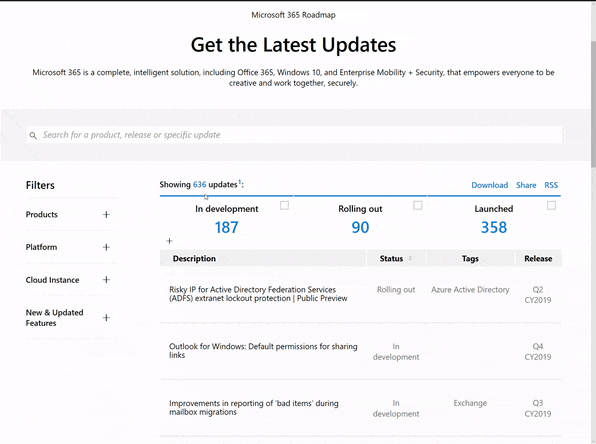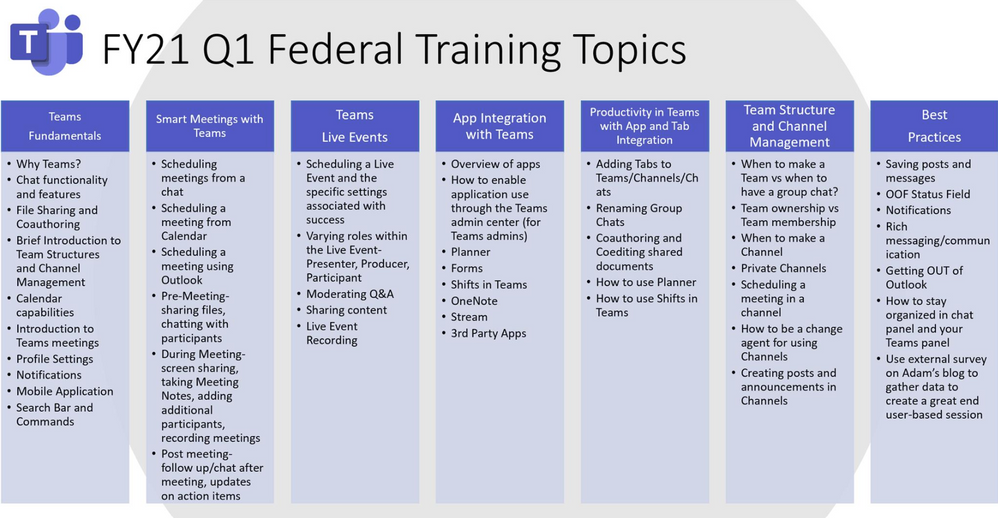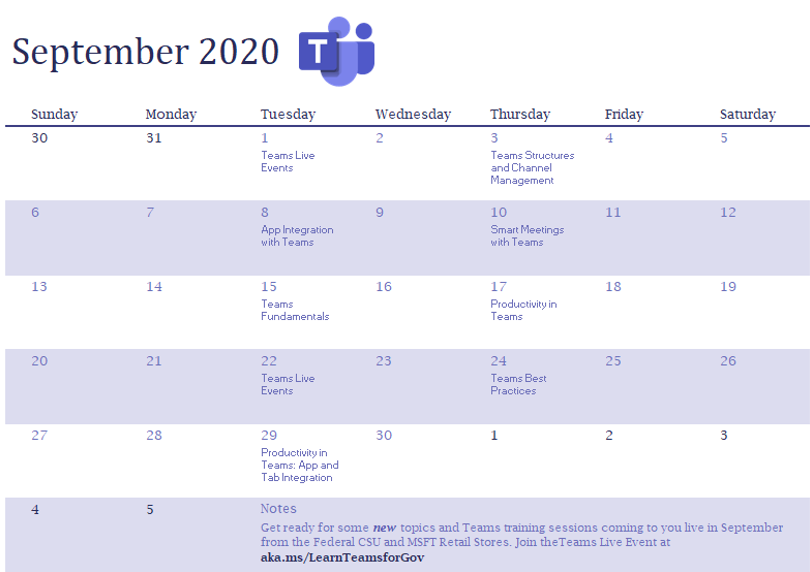
by Scott Muniz | Sep 10, 2020 | Uncategorized
This article is contributed. See the original author and article here.

References and Information Resources
|
Microsoft 365 Public Roadmap
This link is filtered to show GCC, GCC High and DOD specific items. For more general information uncheck these boxes under “Cloud Instance”.
New to filtering the roadmap for GCC specific changes? Try this:

Stay on top of Office 365 changes
Here are a few ways that you can stay on top of the Office 365 updates in your organization.
Microsoft Tech Community for Public Sector
Your community for discussion surrounding the public sector, local and state governments.
Microsoft 365 for US Government Service Descriptions
- Office ProPlus (GCC, GCCH, DoD)
- PowerApps (GCC, GCCH, DoD)
- Flow (GCC, GCCH, DoD)
- Power BI (GCC, GCCH)
- Planner (GCC, GCCH, DoD)
- Outlook Mobile (GCC, GCCH, DoD)
- My Analytics (GCCH, DoD)
- Dynamics 365 US Government
Teams for Government Training Series

Live training accessible via Teams Live Event aka.ms/learnTeamsforGov

Also available: VOD options of past events
Microsoft Lists in Microsoft Teams is now generally available in GCC
Microsoft US Sovereign Cloud Myth Busters – CUI Effectively Requires Data Sovereignty
Secure isolation guidance for Azure and Azure Government
Insider Risk Management and Communication Compliance solutions rolling out to GCC and GCC High cloud environments
Insider Risk Management in Microsoft 365 – Road Map ID: 64187
Communication compliance in Microsoft 365 – Road Map ID: 67112
Extended Offline Access for Microsoft 365 Apps coming to GCC, GCC High, and DOD on October 1, 2020
Extended offline access enables devices running Microsoft 365 Apps to stay activated for up to 180 days without the need to connect to the internet to validate the license and install updates.
SMTP Plus Addressing is now rolling out
Plus Address support allows users to add a suffix to the local-part of their email address to create a secondary address which they can then use as an email address.
App permissions, consent and install in Teams admin center (GA Sep/Oct)
Teams admin center is receiving new features on App Permissions, Consent and Install.
Sideloading and Custom apps are now available in Teams GCC
Power App integration in Teams GCC
Pop Out Chat live in Teams GCC
Teams supports Citrix VDI in Teams GCC
Teams background images in non-optimized VDI environments

Updated Teams meeting experience when joining via meeting URL

Surface Hub Certified for use with Teams GCC
Praise app in Teams (Sep)
Recognize and appreciate work that Teams users do by using praise badges in Microsoft Teams.
Teams templates (Aug/Sep)
Teams templates are pre-built definitions of a team’s structure designed around a business need or project.
Multi-window calling and meetings in Teams
Users can choose to have their Teams calls and meetings pop-out into a separate window.
Org allowed accounts in Teams (GCC only)
Microsoft Teams for iOS and Android now enables administrators to manage which user accounts can sign-in to Microsoft Teams on mobile devices that are managed by Unified Endpoint Management (UEM) providers.
iOS: version 2.0.13 or later
Android: The updated app should be available in the store by the end of June.
Expiring access for external user in SharePoint and OneDrive (Oct)
Tenant admins will be able to create a policy that revokes guest access to documents and files after a set number of days.
Microsoft Lists (GA GCC)
A new Lists home where users will be able to access from the Microsoft 365 suite navigation on the web.
Enforcing SharePoint limits (Sep/Oct)
Enforcing limits scope
- 10,000 SharePoint groups per site (site collection).
- Each SharePoint group can have up to 5,000 users.
- 5,000 role assignments per uniquely permissioned item.
Centralized management for hub permissions (Sep)
Hub permissions enable users to centralize the management of visitor access to associated sites.
SharePoint admin center classic pages retirement
The following pages in the classic SharePoint admin center have been replaced by pages in the new SharePoint admin center and will be removed/retired: “Site Collections”, “Sharing”, “Access control”, and “Geo locations”.
Microsoft 365 IP & URL Endpoint Updates
|
by Scott Muniz | Sep 10, 2020 | Azure, Technology, Uncategorized
This article is contributed. See the original author and article here.
In the last part of this three-part series, Vasiya Krishnan walks us through a demo that shows us how to use Azure SQL Edge to build smarter renewable resources. For an introduction to Azure SQL Edge, watch part one. To see how customers are using Azure SQL Edge, as well as use cases, watch part two.
Watch on Data Exposed
Additional Resources:
Microsoft Industry Solutions
Learn more about Azure SQL Edge
Learn more about the features and building an end to end solution
Azure SQL Edge customer stories
Azure SQL Edge whitepaper
View/share our latest episodes on Channel 9 and YouTube!
by Scott Muniz | Sep 10, 2020 | Azure, Technology, Uncategorized
This article is contributed. See the original author and article here.
The Azure Service Fabric 7.1 fourth refresh release includes bug fixes, and performance enhancements for standalone, and Azure environments has started rolling out to the various Azure regions. The updates for .NET SDK, Java SDK and Service Fabric Runtime is available through Web Platform Installer, NuGet packages and Maven repositories in 7-10 days within all regions.
- Service Fabric Runtime
- Windows – 7.1.458.9590
- Ubuntu 16 – 7.1.454.1
- Ubuntu 18 – 7.1.454.1804
- Service Fabric for Windows Server Service Fabric Standalone Installer Package – 7.1.458.9590
- .NET SDK
- Windows .NET SDK – 4.1.458
- Microsoft.ServiceFabric – 7.1.458
- Reliable Services and Reliable Actors – 4.1.458
- ASP.NET Core Service Fabric integration – 4.1.458
- Java SDK – 1.0.6
Key Announcements
- Extended support for 7.0: Support for all 7.0 based Service Fabric releases will be extended by 3 months until October 1st, 2020. We will take measures to ensure support expiration warnings for 7.0 clusters are removed. Please disregard any newsletters regarding support expiration for Service Fabric 7.0, there will be no impact to clusters.
- Updating/Editing DNS name of a service using Update-ServiceFabricService command: Previously adding a DNS name for a service was only allowed as part of service creation. ServiceDnsName parameter in Update-ServiceFabricService command allows the user to add/edit the DNS name of an already deployed service.
For more details, please read the release notes.
![[Guest Blog] How To pass from 0 to 1: Introduction to Programming World](https://www.drware.com/wp-content/uploads/2020/09/large-335)
by Scott Muniz | Sep 10, 2020 | Uncategorized
This article is contributed. See the original author and article here.
This article was written by Humans of IT Community member Leslie Nicole Ramirez as part of our Guest Bloggers series. The world of programming is filled with 0’s and 1’s – read on to discover how to be a 1 and find your path in the amazing development world. What will allow us to move from Padawan to Jedi? Leslie shares a series of good practices and steps that everyone who wants to be a good programmer should know and put into practice when aspiring to be a good software developer.

When I was writing this article, I remembered the challenging start of my programming experience. I asked some friends why they choose to be a programmer – the opinions varied by person but all of them match with “the start is the hardest part of the path”. However, what makes it so hard is not so much the complexity of concepts; rather, the most common problem starts with the following questions:
- Which programming language should I choose?
- What’s the necessary skill to be a good programmer?
- How can I pass from 0 to 1?
There is a set of good practices that everyone who wants to be a good programmer should know and employ if he aspires to be a good software developer.
Through this blog post, I’d like provide a panorama view of the world of programming. Not specific to a language or tool, but to show you the general steps that you can follow to getting started in the programming world and what are the steps that will take them from 0 to 1.
Remember, we all start off as a 0 in the world of Programming, but you can learn how to be a 1 and find your path in this amazing development world. That said, let’s tackle the first question that is commonly asked, i.e Which programming language should I learn first?
Firstly, ask yourself, what do you want to do as a programmer? There are many great options, for example:
- If you wanna do game development, C# and C++ are good options to consider
- If you wanna create enterprise applications, C# also is a good option
- If you want to get started somewhere, focus on the languages that are somewhat easier to learn, for example, Python
Before you choose your language, think about the following questions:
- How’s the community that supports that development ecosystem?
- Is there enough material to get started without a mentor? (By the way, if you DO need a tech mentor, consider joining the free Microsoft Community Mentors app platform where many MVPs/RDs currently volunteer as mentors!)
- Are you planning to start a career as a developer?
Unicorn tips and answers
- If there’s no supportive community in that ecosystem, you will get less information on issues, and questions on what you are learning. And most of the time that ecosystem tends to disappear because it never hooks with the public.
- The reality is, most programmers learn by themselves via online courses, YouTube channels or some free online courses. If you’re not able to find good options for doing so in your learning path, maybe reconsider your choice and pick another language to delve into.
- If you are planning to get started in the programming world for starting a career and offer your services to big tech companies or maybe as a freelancer, consider looking for jobs offered in different popular platforms such as LinkedIn or Stack Overflow, just to have a grounded opinion of what the companies require of programmers, and from there, work backwards to determine where you should start.
My personal experience
Keeping this in mind, I’ll tell you about my own experience. When I finished school, I already knew that I wanted to study computer science, so I started with a two-year college degree at Technologic of the Americas Institute (ITLA) in the Dominican Republic. In that time, I learned about Java, Pascal, and C#. I fell in love with the last one, because I felt really comfortable with the environment and when I was searching for online resources I found tons of free online courses, tutorials and documentation to start with. After my two years at ITLA, I decided that I wanted to get a job as a programmer. Thankfully, it was relatively easy given that C# and .NET developers are in highly demand worldwide.
Fast forward to now, I still have no regrets choosing C#. The community is truly amazing and there are a lot of people sharing their knowledge and offering support to others. Many of them inspired me to start blogging about C# in Spanish (my native language) via my blog called www.Dominiotic.com where I share my knowledge and experience in the programming world.
I am fortunate to have had a really good experience in the programming world. Of course, there were bumps along the way, but I loved the journey.
Based on my personal experience, here’s my advice for how to pass from 0 to 1:
- Start doing: Do not spend all your time thinking of what you can do. Instead, learn and choose your path!
- 🧗 Challenge yourself and learn new things.
- 🙋 Get involved in community activities: Your community can make all the difference in your experience. Write a blog. Ask questions in a forum. Think about how you can network with others. Even when you are starting out, your content will be really useful for others that may struggle with similar questions.
Though general, these steps are what will make all of the difference to kick off learning programming. For more specific technical skills, here are a few more resources that I recommend:
- Git for version of control
- Programming logic: In this case I choose C# but It’s up to you
- Working with and types with C#
Find your bright path through the programming world – you’ve got this! Another great (and FREE!) resource is Microsoft Learn – you will be surprised by the depth of content you will find there. From beginner to advanced levels, MS Learn is a great place to learn at all levels.
My last piece of advice to you is, never give up. As cliché as it may sound, it’s truly important to remember that you will face challenges in your career. Everyone does. You don’t have to know everything, and neither do you need to get all the concepts at once. Do it at your own rhythm. Wish you the best, and hope you enjoyed reading this article as much as I enjoyed writing it. (♥ω♥ ) ~♪
#0to1programming
#Programming101
#HumansofIT
#CommunityPower

by Scott Muniz | Sep 10, 2020 | Uncategorized
This article is contributed. See the original author and article here.
At Microsoft, we’re honored to partner with the NFL to bring modern fan experiences to the game of football.
The post Empowering NFL clubs and fans with help from the Microsoft Playbook appeared first on Microsoft 365 Blog.
Brought to you by Dr. Ware, Microsoft Office 365 Silver Partner, Charleston SC.




Recent Comments